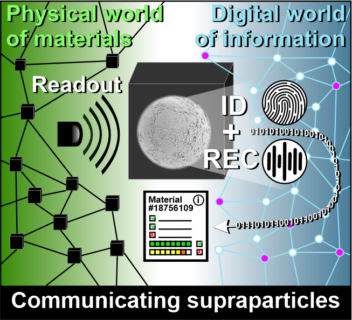Communicating supraparticles to enable perceptual, information-providing matter

Materials are the fundament of our physical world, whereas information and its exchange are the centerpieces of the digital world. Their fruitful synergy offers countless opportunities for realizing innovative concepts that aim at a more sustainable use of our natural resources. Examples of such concepts include the circular economy of materials, predictive maintenance and assisted repair processes, autonomous manufacturing (Industry 4.0), or the interactive material passport. Yet, to date, a perfect connection between physical materials and digital information is missing.
A new class of materials, called communicating supraparticles, has the potential to link the two worlds. Prof. Dr. Karl Mandel (Profesorship for Inorganic Chemistry) and his working group introduce this novel type of supraparticles in their Perspective article in the top-tier Journal Advanced Materials. Their research in the project NANO-ID (Grant No. 03XP0149) was funded by the Federal Ministry of Education and Research (BMBF) and the doctoral scholarship from the German Federal Environmental Foundation (DBU) for the first author of the publication, Jakob Reichstein.
„The tiny communicating supraparticles, which are only a few micrometers in size, are to become an integral part of materials as powder additives in order to transform these previously passive objects into perceptual, information-providing matter. Subsequently, this matter should be able to transmit information about its origin, fate, and integrity on demand“, explains Jakob Reichstein.
Communicating supraparticles obtain their desired properties through their special structure that unites various nanoparticulate and/or (macro)molecular building blocks with spectrally differentiable signals into one entity. Some of these signal building blocks are robust to environmental influences and are suitable to generate a spectral identification signature (ID code). This ID signature allows materials to be linked at any point in their life cycle to digitally stored information, such as their material type, origin, and destination. Other components of the communicating supraparticles, so-called recorders, perceive and memorize different environmental influences in the life cycle of the materials, e.g. temporary temperature increases or the influence of special gases, by exploiting defined, irreversible signal changes. These recorders shall be adjustable to specific materials to be able to provide information about their integrity, for example.
„With their novel combination of functional spectral signals, communicating supraparticles could become a key element for the realization of digital transformation processes in the physical world of materials. The ultimate success of this technology is a highly interdisciplinary challenge to which we would like to contribute with our own research in the coming years“, adds Prof. Mandel.
Further information
Publication: „Communicating supraparticles to enable perceptual, information-providing matter”
Contact
Prof. Dr. Karl Mandel
Professur für Anorganische Chemie
karl.mandel@fau.de
Jakob Reichstein
jakob.reichstein@fau.de
Sponsors


